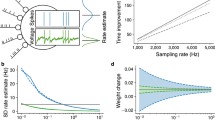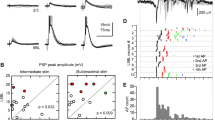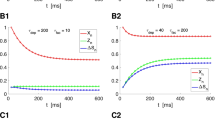Abstract
The synaptic drive from neuronal populations varies considerably over short time scales. Such changes in the pre-synaptic rate trigger many temporal processes absent under steady-state conditions. This paper examines the differential impact of pyramidal cell population bursts on post-synaptic pyramidal cells receiving depressing synapses, and on a class of interneuron that receives facilitating synapses. In experiment a significant shift of the order of one hundred milliseconds is seen between the response of these two cell classes to the same population burst. It is demonstrated here that such a temporal differentiation of the response can be explained by the synaptic and membrane properties without recourse to elaborate cortical wiring schemes. Experimental data is first used to construct models of the two types of dynamic synaptic response. A population-based approach is then followed to examine analytically the temporal synaptic filtering effects of the population burst for the two post-synaptic targets. The peak-to-peak delays seen in experiment can be captured by the model for experimentally realistic parameter ranges. It is further shown that the temporal separation of the response is communicated in the outgoing action potentials of the two post-synaptic cells: pyramidal cells fire at the beginning of the burst and the class of interneuron receiving facilitating synapses fires at the end of the burst. The functional role of such delays in the temporal organisation of activity in the cortical microcircuit is discussed.
Similar content being viewed by others
References
Abbott LF, Varela JA, Sen K, Nelson SB (1997) Synaptic depression and cortical gain control. Science 275: 220–224.
Burkitt AN, Meffin H, Grayden DB (2003) Study of neuronal gain in a conductance-based leaky integrate-and-fire neuron model with balanced excitatory and inhibitory synaptic input. Biol. Cybern. 89: 119–125.
Chance FS, Abbott LF, Reyes AD (2002) Gain modulation from background synaptic input. Neuron 35: 773–782.
DeFelipe J, Elston GN, Fujita I, Fuster J, Harrison KH, Hof PR, Kawaguchi Y, Martin KAC, Rockland KS, Thomson AM, Wang SSH, White EL, Yuste R (2002) Neocortical circuits: Evolutionary aspects and specificity versus non-specificity of synaptic connections. Remarks, main conclusions and general comments and discussion. J. Neurocytol. 31: 387–416.
Destexhe A, Rudolph M, Paré D (2003) The high-conductance state of neocortical neurons in vivo. Nat. Rev. Neurosci. 4: 739–751.
Fellous J-M, Rudolph M, Destexhe A, Sejnowski TJ (2003) Synaptic background noise controls the input/output characteristics of single cells in an in vitro model of in vivo activity. Neuroscience 122: 811–829.
Wang Y, Markram H (2000) Organizing principles for a diversity of gabaergic interneurons and synapses in the neocortex. Science 287: 273–278.
Kawaguchi Y, Kondo S (2002) Parvalbumin, somatostatin and cholecystokinin as chemical markers for specific GABAergic interneuron types in the rat frontal cortex. J. Neurocytology 31: 277–287.
Liaw J-S, Berger TW (1996) Dynamic synapses: a new conceptof neural Representation and Computation. Hippocampus 6: 591–600.
Markram H, Wang Y, Tsodyks M (1998) Differential signalling via the same axon of neocortical pyramidal neurons. Proc. Natl. Acad. Sci. USA 95: 5323–5328.
Markram H, Toledo-Rodriguez M, Wang Y, Gupta A, Silberberg G, Wu C (2004) Interneurons of the neocortical inhibitory system. Nat. Rev. Neurosci. 5: 793–807.
Melamed O, Silberberg G, Markram H, Gerstner W, Richardson MJE (2005) Subthreshold cross-correlations between cortical neurons: A reference model with static synapses. Neurocomputing (in press).
Richardson, MJE (2004) Effects of synaptic conductance on the voltagedistribution and Firing Rate of Spiking Neurons. Phys. Rev. E 69: art-no 051918.
Sanchez-Vives MV, McCormick DA (2000) Cellular and network mechanisms of rhythmic recurrent activity in neocortex. Nat. Neurosci. 3: 1027–1034.
Shu YS, Hasenstaub A, McCormick DA (2003) Turning on and off recurrent balanced cortical activity. Nature 423: 288–293.
Silberberg G, Wu CZ, Markram H (2004) Synaptic dynamics control the timing of neuronal excitation in the activated neocortical microcircuit. J. Physiol-London 556: 19–27.
Somogyi P, Tamas G, Lujan R, Buhl EH (1998) Salient features of synaptic organisation in the cerebral cortex. Brain Res. Rev. 26: 113–135.
Stroeve S, Gielen S (2001) Correlation between uncoupled conductance-based integrate-and-fire neurons due to common and synchronous presynaptic firing. Neural. Comput. 13: 2005–2029.
Thomson AM, Deuchars J, West DC (1993) Single axon excitatory postsynaptic potentials inneocortical interneurons Exhibit Pronounced Paired Pulse Facilitation. Neuroscience 54: 347–360.
Thomson AM, Deuchars J (1994) Temporal and spatial properties of local circuits in neucortex. Trends in Neurosciences 17: 119–126.
Tsodyks M, Markram H (1997) The neural code between neocortical pyramidal neurons depends on neurotransmitter release probability. P. Natl. Acad. Sci. USA 94: 719–723.
Tsodyks M, Pawelzik K, Markram H (1998) Neural networks with dynamic synapses. neuralcomput. 10: 821–835.
Wilson CJ and Kawaguchi Y (1996) The origins of two-state spontaneous membrane potential fluctuations of neostriatal spiny neurons. J Neurosci. 16: 2397–2410.
Author information
Authors and Affiliations
Corresponding author
Rights and permissions
About this article
Cite this article
Richardson, M.J.E., Melamed, O., Silberberg, G. et al. Short-Term Synaptic Plasticity Orchestrates the Response of Pyramidal Cells and Interneurons to Population Bursts. J Comput Neurosci 18, 323–331 (2005). https://doi.org/10.1007/s10827-005-0434-8
Received:
Revised:
Accepted:
Issue Date:
DOI: https://doi.org/10.1007/s10827-005-0434-8




